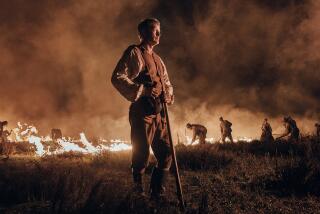Hans Christian Andersen’s Tales Also Draw Scholarly Audiences : Literature: Serious study of the Danish author challenges his image as writer of stories for children.
- Share via
ODENSE, Denmark — Was Hans Christian Andersen simply a talented writer of children’s fairy tales, or should adults be probing his works for deeper meanings?
Danish academics, believing there is more to their country’s greatest author than most readers realize, held an international conference here to consider his work in an adult perspective--and were surprised at the results.
Most Westerners, familiar from childhood with touching tales such as “The Ugly Duckling,” consider Andersen exclusively a children’s writer, according to Danish lecturer Johan de Mylius.
But academics in Eastern Europe, the Soviet Union and the Far East interpret his fairy tales on a more intellectual level--a view Andersen would have approved of, he said.
“In Denmark, we accept that Andersen can also be for an adult audience, but on the whole the West has so far failed to realize this,” said de Mylius, who organized the conference and who is head of Odense University’s International H. C. Andersen Research and Study Center.
“In Russia and Eastern Europe the situation is quite different,” de Mylius said. “There, Andersen is traditionally seen as a major literary figure, a philosophical writer and an integral part of every student’s ‘spiritual baggage.’
“In China and Japan, Andersen enjoys immense popularity. In many parts of the Far East, budding writers of children’s books model their style on Andersen’s techniques.”
About 70 academics, researchers and translators from 15 countries spent the weeklong conference exchanging ideas about the significance of Andersen’s work.
“One theme that came out strongly was Andersen’s view of the relationship between man and nature,” said de Mylius. “It’s a view that is familiar to us today.”
In the fairy tale “The Dryad,” for instance, Andersen described a small tree uprooted from the countryside and replanted in Paris for the World Exhibition of 1868, which he had visited.
“The rural tree spirit longs for city life and the bright lights,” said de Mylius. “But she loses her roots in the big city and dies--a warning against cutting our ties with nature as we rush for modernity and the excitement of the city.”
On the other hand, in “The Little Mermaid,” an earlier tale, the mermaid survives the transition from nature to the world of men, reflecting Andersen’s belief that man and nature can be reconciled.
His views of artistic inspiration show a psychological awareness far ahead of his time, de Mylius believes.
“He was a Romanticist, believing in divine inspiration, but he thought poetry also grew out of the hidden forces of the unconscious, that sexuality and repression were behind poetry and other forms of art.”
In “Auntie Toothache,” a pessimistic story about a student who wants to be a poet, his aunt encourages him by day, but appears by night as a satanic figure who tells him suffering--in the form of toothache--is the price of great poetry. The boy resolves to give up poetry, but dies tragically.
“Andersen is saying that the roots of poetry lie in the suffering of the individual, but also that the aunt’s behavior was based on her repressed sexuality,” said de Mylius. “Teeth were a strong sexual symbol for Freud too, years later.
“Andersen saw that behind all that is cozy and familiar there lies a dark side, a Satanic aspect.”
Andersen was born to a poor washerwoman in 1805 in Odense, on the central Danish island of Fyn, but wrote most of his prodigious output of fairy tales, travel books and plays after moving to Copenhagen in his teens.
Odense University set up the institute in 1988 to stimulate overseas interest and university level studies of Denmark’s most famous author.
Despite the respect Eastern academics hold for Andersen’s tales, doubts linger among Western students.
“My students are fascinated by Andersen,” said Danish-American researcher Niels Ingwersen of University of Wisconsin, Madison. “They tend, though, to react against any moral and philosophical interpretation of Andersen’s fictional universe.”
Andersen’s first collection of 23 fairy tales was published in 1835 under the title “Fairy Tales Told for Children,” but the words “told for children” were dropped from the title page in subsequent editions.
Andersen himself rejected any suggestion that his fairy tales were written purely for children. On hearing of plans to erect a statue of him with children clustering around, Andersen wrote angrily, “My blood boiled and I spoke my mind in no uncertain terms.
“My aim is to be a poet for all ages, the naive element is only part of the tale.”
Andersen died in 1875, leaving behind work that included 167 fairy tales, 47 plays, 14 novels and 23 travel books. His fairy tales have been translated into more than 100 languages.
More to Read
Sign up for our Book Club newsletter
Get the latest news, events and more from the Los Angeles Times Book Club, and help us get L.A. reading and talking.
You may occasionally receive promotional content from the Los Angeles Times.







